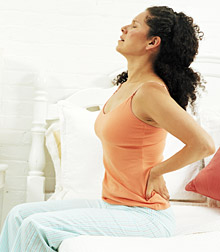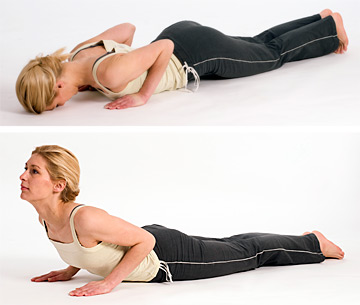Self-Care for Back Pain: Exercises to Help the Healing Process
By Marc Heller, DC
When it comes to back pain, your first thoughts may be to take over-the-counter pain medication and rest whenever possible. Two bad options. First, medication is only going to temporarily relieve the pain, if at all, and may be accompanied by various unpleasant side effects attributable to drugs. Second, rest may actually hurt more than help. While you're seeing your chiropractor, there are a few things
you can do at home to help the healing process. Believe it or not, it's based on the simple principle of
movement.
Whenever I see a patient with back pain, I always ask, "What do you do when you are in pain? What exercises help your pain?" I am continually surprised that very few patients know what self-care to do when they have an acute episode of pain. That includes motivated patients and patients I have seen before and carefully shown the right exercises. Maybe it is because when you hurt, you stop thinking clearly; or maybe it is fear that the pain will get worse. Both are valid excuses. Most of them just rest, ice the area, and use non-steroidal anti-inflammatory drugs (without realizing that NSAIDs actually block healing). Many of them say, "I hurt too much to exercise."
Why Movement Matters
 The problem with this is that when you stop moving, when you are still, everything tightens up, circulation slows down, and pain chemicals accumulate in your muscles and joints. It's like waking up after sleeping in a cold room on a lousy mattress with a draft. If you get moving, you'll typically start to feel better.
The problem with this is that when you stop moving, when you are still, everything tightens up, circulation slows down, and pain chemicals accumulate in your muscles and joints. It's like waking up after sleeping in a cold room on a lousy mattress with a draft. If you get moving, you'll typically start to feel better.
So, here's the number-one rule to remember: Don't stop moving when you hurt. I know, you are in pain and afraid to move, and sudden movements may cause your back to "grab" or spasm. I am not telling you to ignore the pain. What I am saying is that you need to find movements that will ease your pain. In many cases, the most important thing to do when you hurt is to keep moving. The body often tightens up and limits your motion. If you find a motion that doesn't hurt you, it will probably help you. When you are hurting, you may not be able to do your usual activities, but you must keep moving. Try walking slowly, especially on flat and even ground. Try walking up a hill (you can walk up a hill without walking down, on a treadmill). Try swimming or simple motions in chest-deep water. Try basic pelvic tilts, staying within a pain-free range.
Here are some basic principles. The movement should be pain free (or at least cause minimal pain while being performed). When you have finished doing the exercise, your pain should be somewhat diminished. You should feel that you can move more freely. Your back should feel straighter and less "kinked."
 Backward bending is a great exercise when you're suffering from low back pain. Start on the floor or other stable surface (top picture), then slowly raise your upper body up while keeping your lower body stationary (bottom picture). The final step involves extending your arms up (much like a push-up).
Basic Exercises for Low Back Pain
Backward bending is a great exercise when you're suffering from low back pain. Start on the floor or other stable surface (top picture), then slowly raise your upper body up while keeping your lower body stationary (bottom picture). The final step involves extending your arms up (much like a push-up).
Basic Exercises for Low Back Pain
Here are two basic examples of self-care exercises that have stood the test of time. Many of my patients have found variations on these and other types of movements that act as "reset" buttons for their typical pain. You are the one living in your body; you are the most likely one to know what is working for you.
Lower back diagnosis is often very difficult and confusing. For the sake of this article, let's divide low back pain exercises into two categories: exercises that make your back feel better when you bend backward, and exercises that make your back feel better when you bring your leg toward your chest.
Backward Bending (extension of the lumbar spine). An exercise called the McKenzie extension is the first thing you should try if you have sciatica (pain running down your leg). If these exercises work, your pain will diminish and may centralize, which is a good thing. Centralize means your pain goes less far down your leg, and you may feel it closer to the spine. Bending backward may not feel good at first, but you should feel better immediately afterward. If you feel worse afterward or the pain goes farther down your leg, stop, as this is not the exercise for you.

